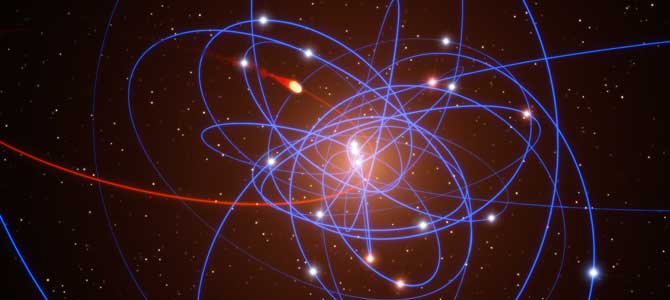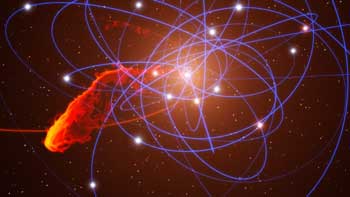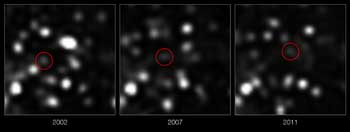Disaster looms for gas cloud falling into Milky Way’s central black hole

The normally quiet neighborhood around the massive black hole at the center of our Milky Way Galaxy is being invaded by a gas cloud that is destined in just a few years to be ripped, shredded and largely eaten.
Many, if not all, galaxies have massive black holes at their centers. But this supermassive black hole is the only one close enough for astronomers to study in detail, so the violent encounter is a unique chance to observe what until now has only been theorized: how a black hole gulps gas, dust and stars as it grows ever bigger.
“When we look at the black holes in the centers of other galaxies, we see them get bright and then fade, but we never know what is actually happening,” said Eliot Quataert, a theoretical astrophysicist and University of California, Berkeley professor of astronomy. “This is an unprecedented opportunity to obtain unique observations and insight into the processes that go on as gas falls into a black hole, heats up and emits light. It’s a neat window onto a black hole that’s actually capturing gas as it spirals in.”

“The next two years will be very interesting and should provide us with extremely valuable information on the behavior of matter around such massive objects, and its ultimate fate,” said Reinhard Genzel, professor of physics at both UC Berkeley and the Max Planck Institute for Extraterrestrial Physics (MPE) in Garching, Germany.
The discovery by Genzel; Stefan Gillessen of the MPE; Quataert and colleagues from Germany, Chile and Illinois will be reported online Wednesday, Dec. 14, in advance of the Jan. 5 publication of the news in the British journal Nature.
Since 2008, Genzel, Gillessen, Quataert and their team have seen the gas cloud – about three times the mass of Earth – speeding up as it has fallen deeper into the gravitational whirlpool of the black hole. Its edges are already beginning to fray.
”It is not going to survive the experience,” said first author Gillessen. He built the infrared detector on the European Southern Observatory’s Very Large Telescope in Chile used to observe the movement of stars and gas in the center of the Milky Way, 27,000 light years from Earth.
By 2013, scientists should see outbursts of X-rays and radio waves as the cloud – composed mostly hydrogen and helium gas – gets hotter and is torn asunder. The light emitted around the black hole could increase by a hundredfold to a thousandfold, Quataert calculated.
The Chandra X-ray satellite has already scheduled its largest single chunk of observation time in 2012 near the Milky Way’s central black hole.
Black hole normally quiet
Astronomers have long observed clouds of gas streaming toward the center of our Milky Way Galaxy, presumably destined to fall into the 4.3 million solar-mass black hole lurking there. But this black hole “has a surprisingly low amount of matter falling inward at the moment,” Quataert said.
Since MPE astronomers began observing the black hole in 1992, they have seen only two stars as close as this gas cloud to the black hole. The crucial difference is that those stars “passed unharmed through their closest approach, (while) the gas cloud will be completely ripped apart by the tidal forces around the black hole,” Gillessen said.

This particular cold cloud (about 550 Kelvin or 280 degrees Celsius) may have formed when gas pushed by stellar winds from two nearby stars collided, and is glowing under the strong ultraviolet radiation from surrounding hot stars. As the cloud skirts the gravitational influence of the black hole, it will come within about 40 billion kilometers ‑ 250 times the distance between Earth and the sun ‑ of the event horizon, the limit beyond which nothing, not even light, can escape.
Even at that distance, the gas will get stretched out, with probably half spiraling into the black hole and the rest flung outward.
As the cloud falls towards the black hole – its current velocity is about 2,350 kilometers per second, twice what it was seven years ago – it will interact with the hot gas present in the accretion flow around the black hole and become disrupted by turbulent interaction.
Thanks to the Very Large Telescope’s years of observations of the black hole at many different wavelengths, the scientists were able simulate the time evolution of the cloud and predict that the temperature of the gas cloud should increase rapidly to several million Kelvin near the black hole, dramatically increasing X-ray emissions.
Related information:
- A gas cloud on its way towards the supermassive black hole at the Galactic Centre (published online in Nature, 12/14/11)
- European Southern Observatory (ESO) press release (with video)
